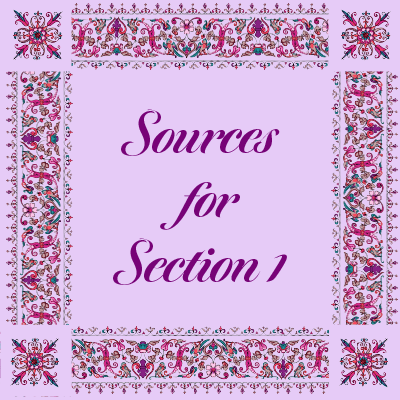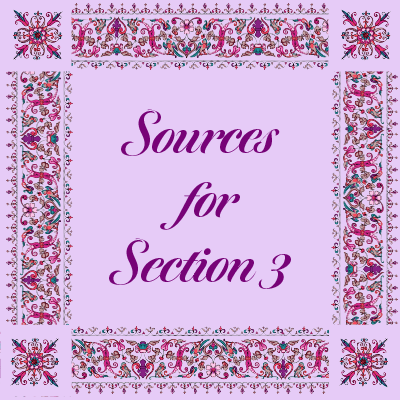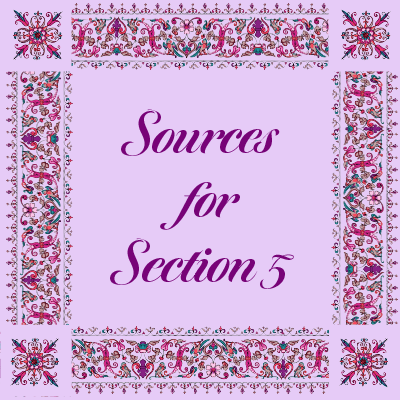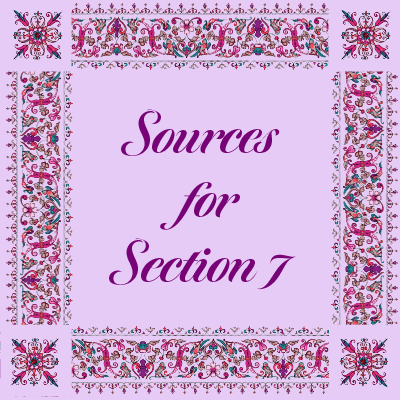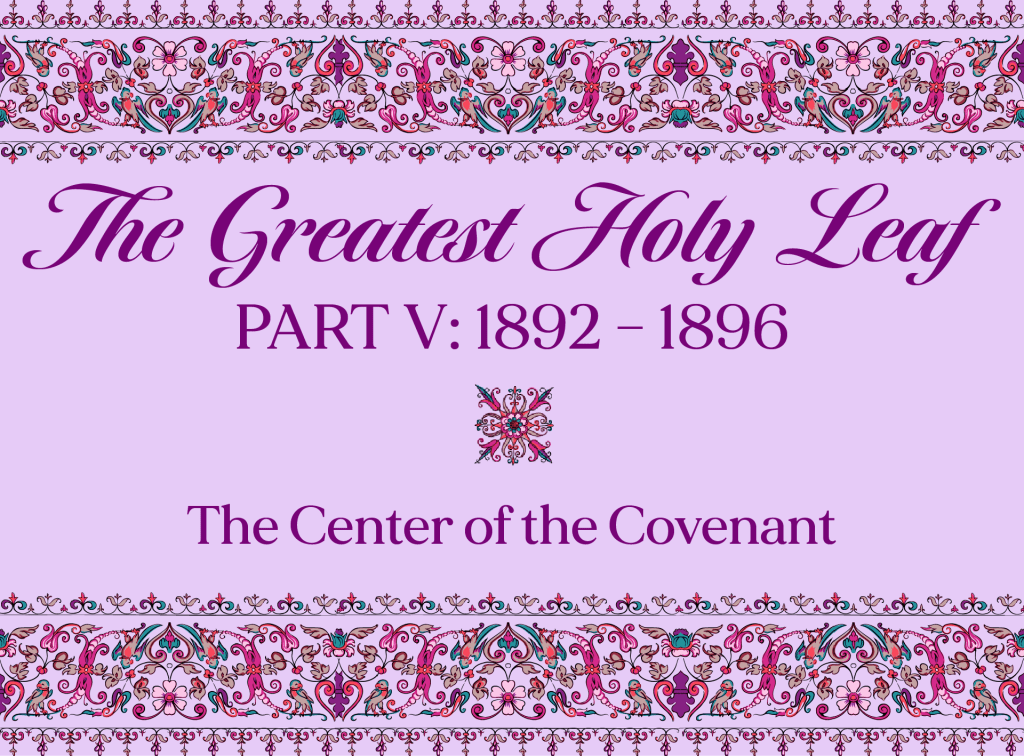
Written and illustrated by Violetta Zein
This part covers the life of the Greatest Holy Leaf from the age of 46 in 1892 to the age of 50 in 1896.
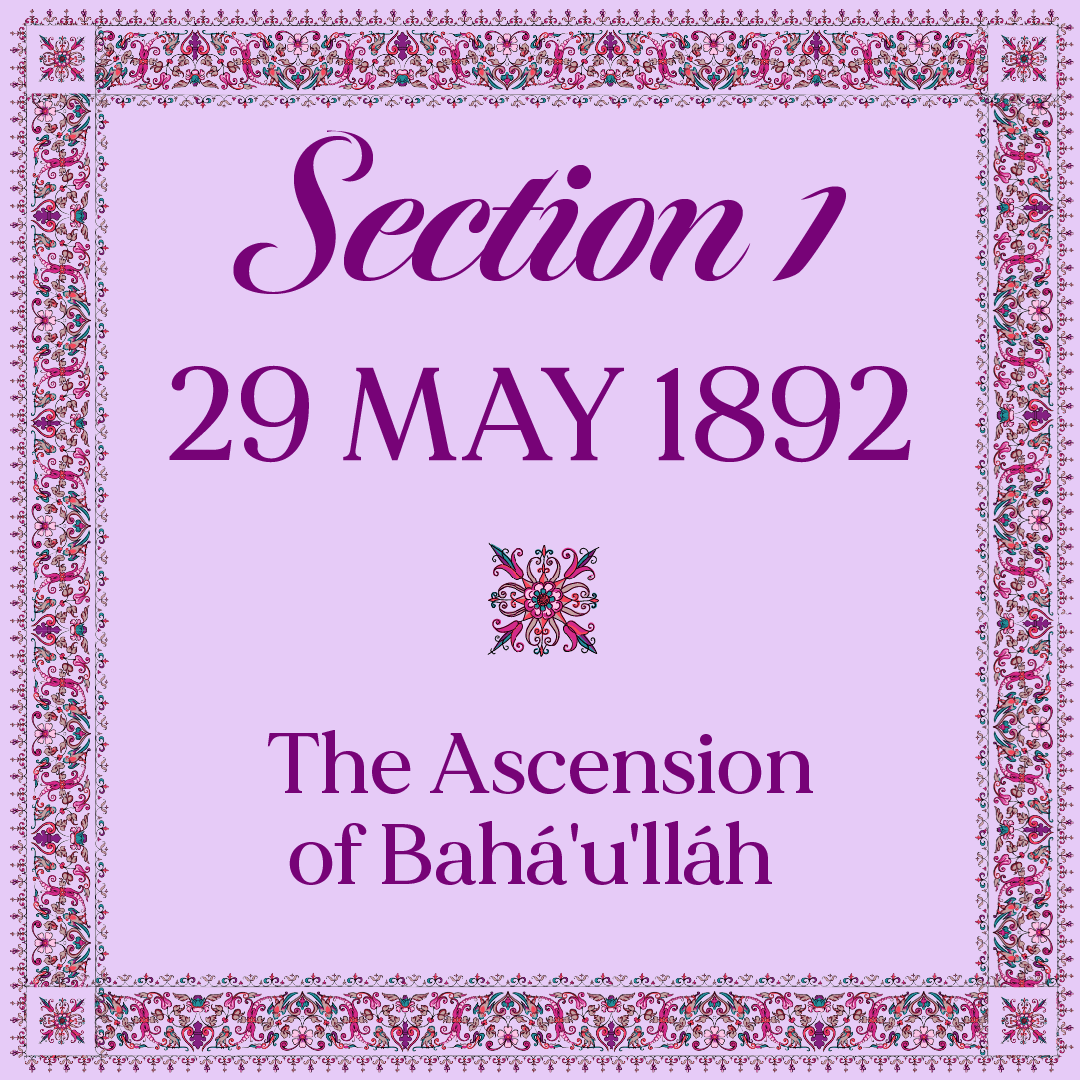

1956 – 1958 photograph of the Mansion of Bahjí. Source: Bahá'í Media Bank, © Bahá'í International Community 2024.
On Sunday 8 May 1892, in the evening, 50 days after Naw-Rúz, Bahá'u'lláh contracted a fever, but did not mention it to anyone.
Bahá'u'lláh’s illness lasted three weeks. At times, Bahá'u'lláh would receive believers, and at times, no one was admitted into His presence.
On 17 May 1892, Bahá'u'lláh sent a servant from Bahjí to the house of ‘Abbúd with a worrisome message for 'Abdu'l-Bahá and the Greatest Holy Leaf:
I am not well, come to Me and bring Khánum.
'Abdu'l-Bahá and Bahíyyih Khánum left for Bahjí immediately while Munírih Khánum stayed at home with the children, filled with anxiety.
Bahíyyih Khánum moved into the Mansion of Bahjí during Bahá'u'lláh’s illness in order to be near Him and help as much as she could.
On Sunday 22 May 1892, Bahá'u'lláh addressed Himself to the women of the Holy Family gathered around His bedside, offering them words of comfort and assuring them that He had entrusted them to the care of 'Abdu'l-Bahá in a special document, a direct hint at His Will and Testament.

The very room in which Bahá'u'lláh’s Ascension took place, at 3 in the morning on 29 May 1892. Source: Bahá'ís of the United States.
Eight hours after sunset, in the early morning of Saturday 29 May 1892, Bahá'u'lláh passed away at the age of 75, at three o’clock in the morning in His room at the Mansion of Bahjí, with no sign of the fever that had ebbed and flowed for nearly three weeks.
His spirit had winged its flight to “other dominions” where “the eyes of the people of names had never fallen.”
A horseman was immediately dispatched to 'Akká to carry the news to the Muftí, and the seven minarets of the Mosque of Al-Jazzár called out the customary proclamation, only issued in the event of the death of greatly honored, highly learned and holy men:
God is great! He giveth life! He taketh it again! He dieth not, but liveth for evermore!
Unlike the tragedy of the Bábí community after the martyrdom of the Báb, the Bahá'í community would never suffer one second of confusion and lack of leadership.
The cloud of hopelessness and despair that briefly settled over the community of believers were soon lifted. Bahá'u'lláh had ensured the continuity of His infallible guidance, conferred upon 'Abdu'l-Bahá, and the community recognized in Him its Guide, Solace, and Champion.
The Ascension of Bahá'u'lláh had ushered in “the Day which shall not be followed by night.”
It was the beginning of the ministry of 'Abdu'l-Bahá, the Center of the Covenant, and a new era of service in the life of the Greatest Holy Leaf.

'Abdu'l-Bahá, Center of the Covenant of Bahá'u'lláh. This colorized portrait of Him in Paris in October 1911, was the first He allowed since 1868 in Adrianople, and was taken exactly 19 years after the Ascension of Bahá'u'lláh. 'Abdu'l-Bahá’s signature in Persian and in English can be seen in the bottom right. Source: Bahá'í Media Bank © Bahá'í International Community 2024.
Shoghi Effendi called the Kitáb-i-‘Ahd a “unique and epoch-making Document.”
Enshrined in Bahá'u'lláh’s Will and Testament were provisions to not only protect the Faith from Covenant-breakers, but also propagate it through the entire world.
'Abdu'l-Bahá was now the Center of the Covenant, the undisputed head of the Bahá'í Faith and the only authorized interpreter of the Holy Writings of Bahá'u'lláh. He was the legitimate successor of the Manifestation of God, and He would bring the Cause of Bahá'u'lláh to the continents of Africa, Europe and America Himself.
But before all this was to happen, the Covenant of Bahá'u'lláh would be, in Shoghi Effendi’s words, “baptized with a fire which was to demonstrate its solidity and proclaim its indestructibility to an unbelieving world.”
This attack on the Covenant would be the worst episode since the Most Great Separation, 27 years before in Edirne.
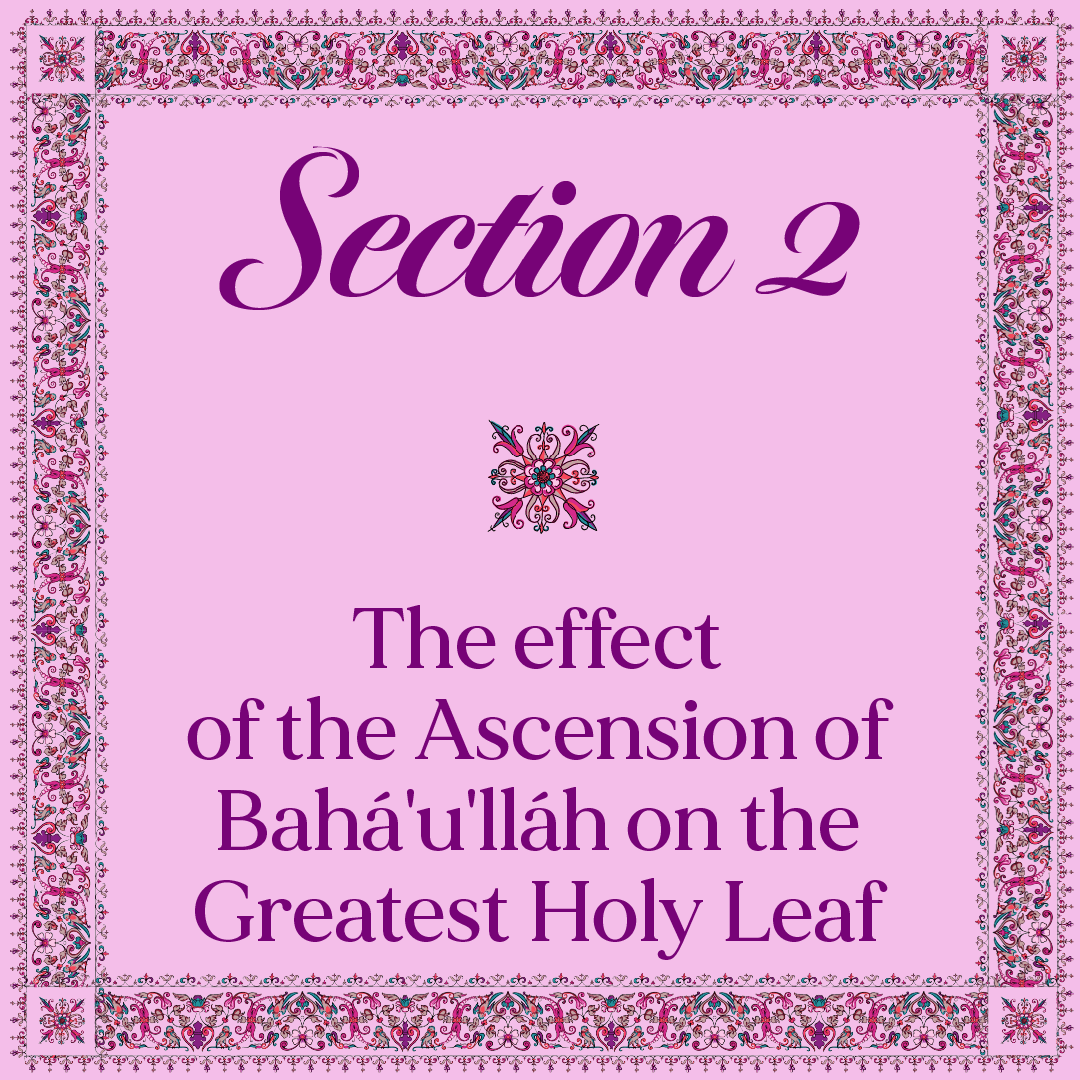

Some relics of Bahá'u'lláh, to illustrate a story relating to His belongings, later stolen by the Covenant-breakers. Source: Bahá'í Sacred Relics.
Bahíyyih Khánum had been devastated with the passing of her adored mother Ásíyih Khánum in 1886, then one year later in 1887, of her uncle Mírzá Músá, and another year later of her nephew—'Abdu'l-Bahá’s beloved son—Ḥusayn Effendi in 1888 at the age of four.
Four years after the passing of Ḥusayn Effendi, at the age of 46, Bahíyyih Khánum lost the center of her entire life, her sun, her stars, her moon, her Father, Bahá'u'lláh, Whom she had lived to serve since her childhood.
The passing of her mother had been a shock and had caused her pain and sorrow, but the Ascension of Bahá'u'lláh caused Bahíyyih Khánum lasting heartbreak because of the devastating impact it had on the Bahá'í Faith and the unfaithful family of Bahá'u'lláh, her own immediate family.
Bahá'u'lláh’s Ascension set in motion a crisis that would last for more than six decades and would leave its mark on the Bahá'í community and the Holy Family for generations.
It was, however, the depth of this crisis of the Covenant that marked the Greatest Holy Leaf for greatness, and directed her services for the last 40 years of her earthly life.
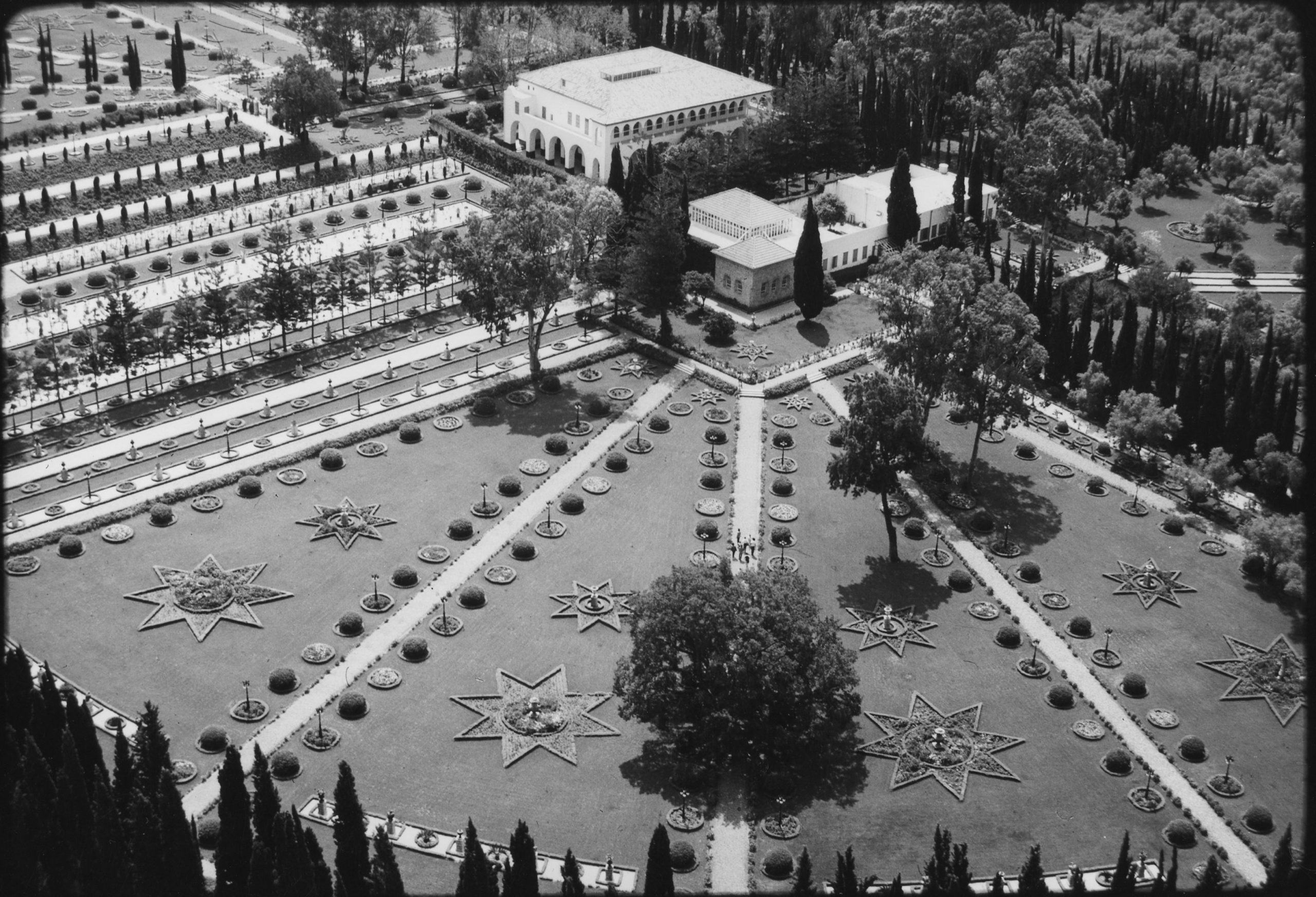
Aerial view of the Shrine of Bahá’u’lláh, Mansion of Bahjí and surrounding gardens, 1976. Source: Bahá'í Media Bank, © Bahá'í International Community 2024.
Bahíyyih Khánum’s steadfastness, pure faith, loyalty, unwavering dedication, and sacrificial service were steeled by a resolve so powerful that nothing could shake it.
Despite her physical appearance of frailty, Bahíyyih Khánum would be an unmovable tower of strength until the end of her days, and protect the Covenant during both the ministries of 'Abdu'l-Bahá, her beloved older Brother, and Shoghi Effendi, the Guardian of the Faith and her great-nephew.
In the next 40 years of her life, Bahíyyih Khánum would be forced to sever long-standing and intimate ties with some of her closest family members and friends, as they each, one after the other, fell prey to the spiritual disease of Covenant-breaking.
Over and over again, Bahíyyih Khánum would discard lesser loyalties of family and friendship in favor of her allegiance to the Faith and the Covenant.
A new era of service was beginning for Bahíyyih Khánum, as she became the pillar of her brother 'Abdu'l-Bahá, now the Center of the Covenant. In this role, all of Bahíyyih Khánum’s natural abilities and her stainless character would shine for all to see.
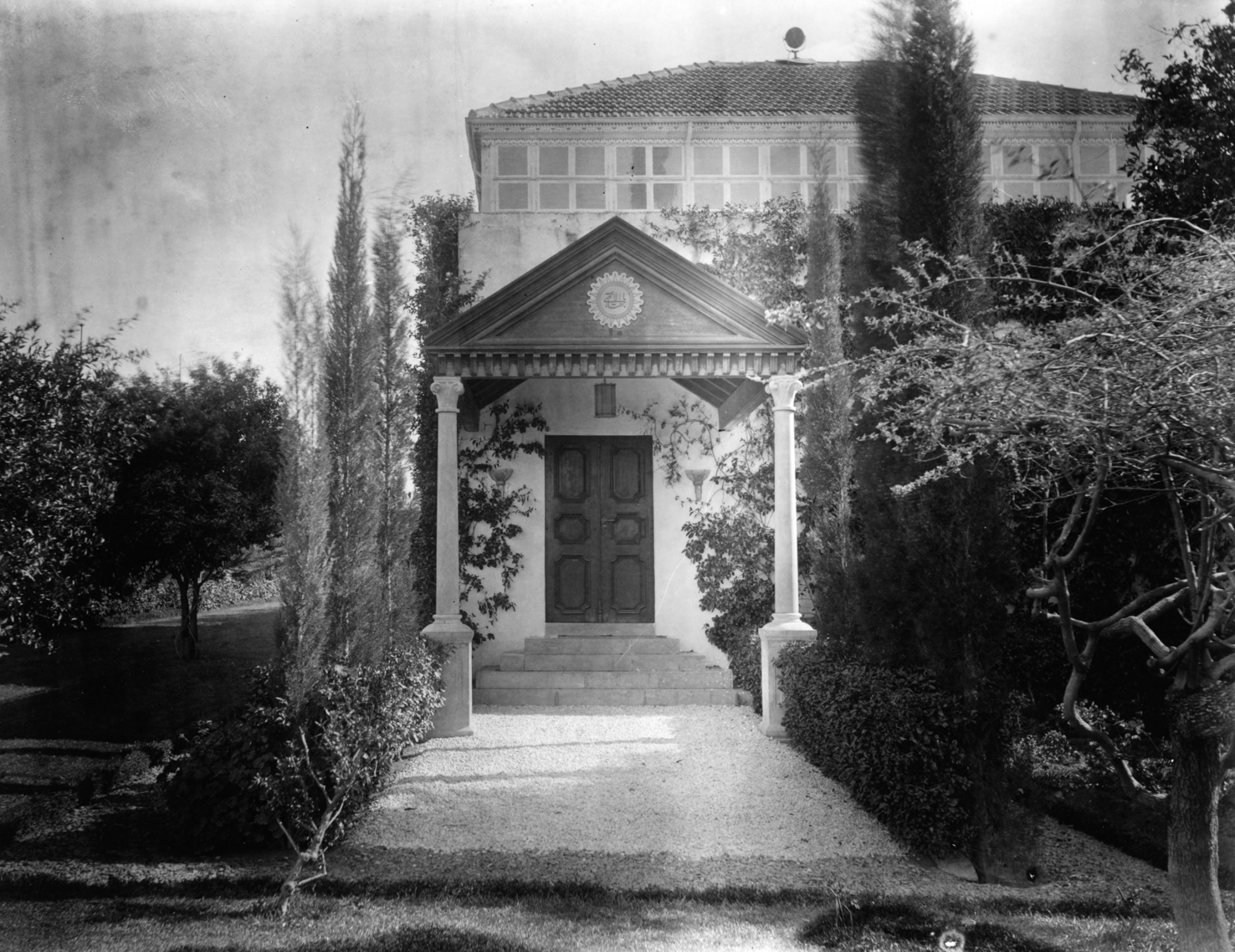
Entrance to the Shrine of Bahá’u’lláh, 1940. Source: Bahá'í Media Bank, © Bahá'í International Community 2024.
Immediately after Bahá'u'lláh’s passing, Bahíyyih Khánum wrote a letter describing her immense sense of loss and the grief of the Holy Family with counsels on how to deal with such feelings in a last paragraph which is characteristic of her optimism and steadfastness:
In reality no pen can depict the poignant feeling that surges in our hearts.
Every expression would prove utterly inadequate, even less than the eye of a needle, inasmuch as words and syllables are incapable of conveying the intensity of this dire suffering. They are but a tiny drop compared to an ocean. Even in the vast immensity of inner significances and expositions nothing can portray this calamitous event…
During this dark and dreadful calamity, and to this God bears me witness, our souls melted and our eyes unceasingly rained with tears.
Nevertheless, when faced with the irrevocable decree of the Almighty, the vesture that best befits us in this world is the vesture of patience and submission, and the most meritorious of all deeds is to commit our affairs into His hands and to surrender ourselves to His Will.
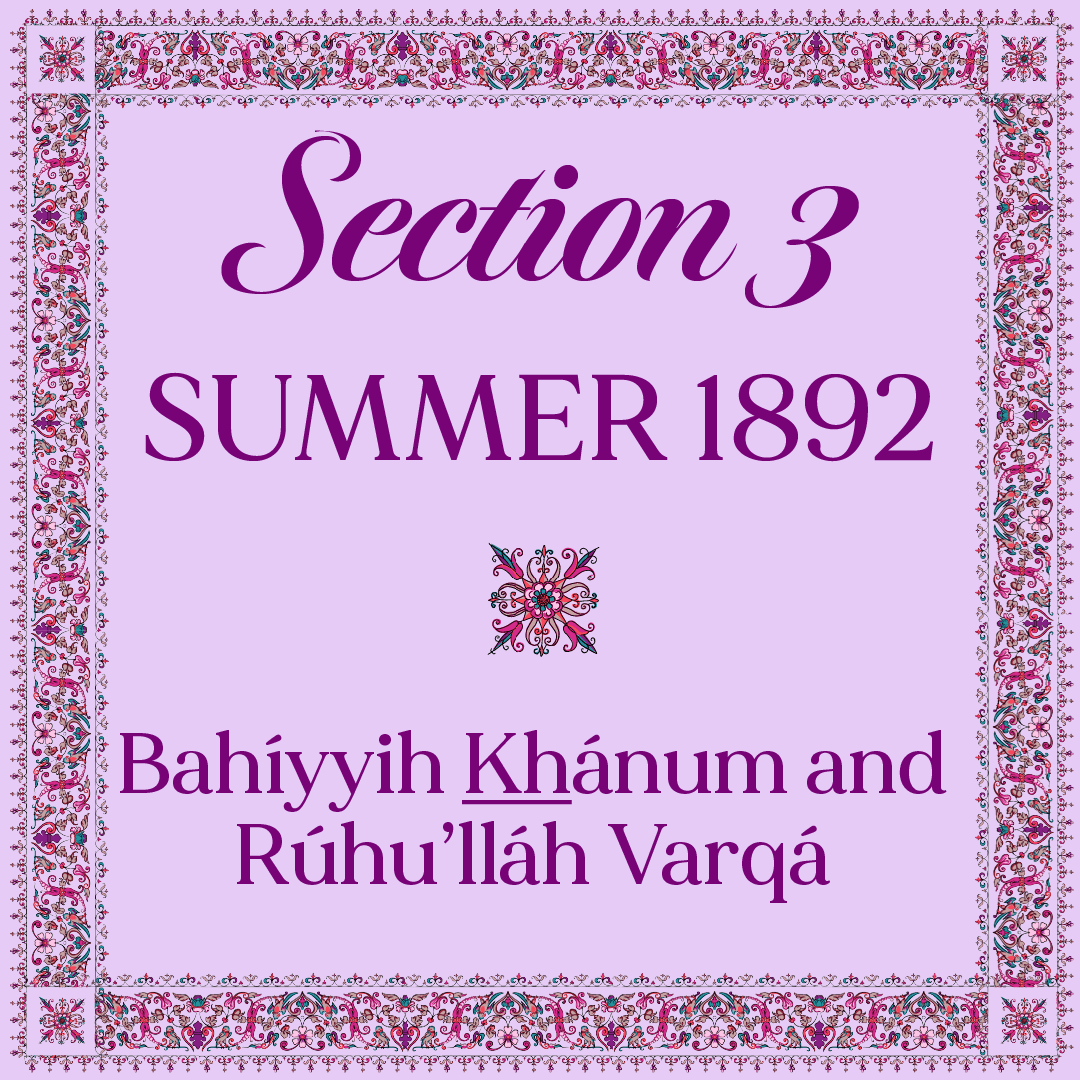
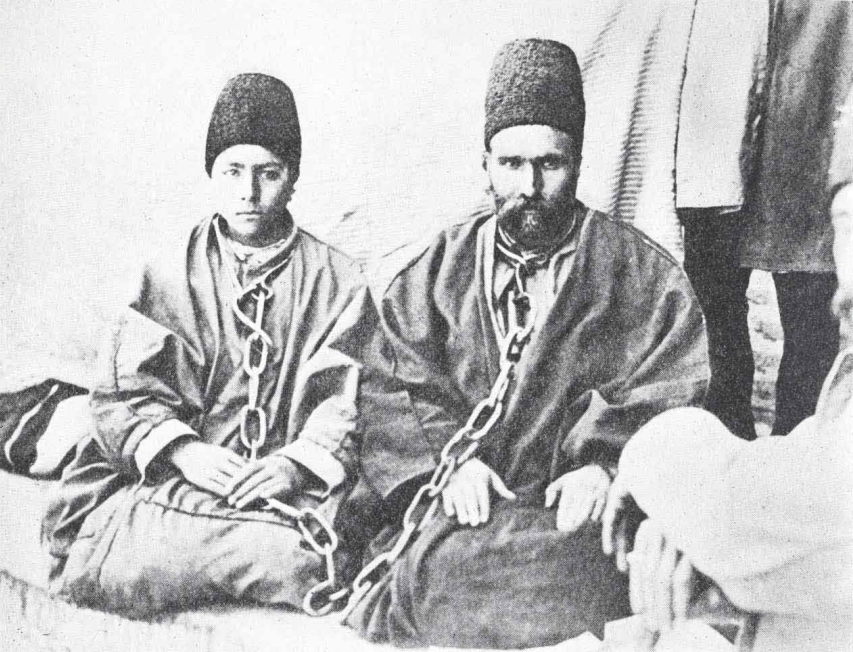
Varqá and his son Rúḥu’lláh, in prison before their martyrdom in 1896, from The Bahá’í World. Vol 3, page 74, Source: Bahaimedia.
In 1891, one year the Ascension of Bahá'u'lláh’s, Varqá came to 'Akká on pilgrimage with his two sons, ‘Azízu’lláh, the eldest, and Rúḥu’lláh, who was 8 years old. All three had the bounty of entering the presence of Bahá'u'lláh several times.
Shortly after the Ascension of Bahá'u'lláh, Varqá and his sons ‘Azízu’lláh and Rúḥu’lláh came back to 'Akká on pilgrimage and attained the presence of 'Abdu'l-Bahá.
Both the Master and the Greatest Holy Leaf were filled with admiration and love for Rúḥu’lláh and enjoyed talking to him.
One day, ‘Azízu’lláh, and Rúḥu’lláh were playing in the garden. Bahíyyih Khánum called the boys over to her, and they sat down. There were two other young men there, Mírzá Badí’u’lláh, 25, and Mírzá Ḍíyá‘íyyu’lláh, 28, two of Bahá'u'lláh’s sons from His second wife.
Mírzá Badí’u’lláh and Mírzá Ḍíyá‘íyyu’lláh, would soon become active Covenant-breakers, eagerly joining the ranks of their older brother Mírzá Muḥammad-'Alí, the Archbreaker of the Covenant of Bahá'u'lláh.
The Greatest Holy Leaf asked ‘Azízu’lláh, and Rúḥu’lláh what they said to people when they were teaching the Faith.
Rúḥu’lláh answered:
We tell them that God has manifested Himself.
Bahíyyih Khánum was very surprised that they would lead with such a bold and direct statement in their first approach to teaching, but Rúḥu’lláh explained:
We don't tell this to everybody. We only say it to those who have the capacity to hear such a statement.
Curious, Bahíyyih Khánum asked:
How would you know such people?
Rúḥu’lláh explained their simple yet straightforward approach in determining of the person in front of them had the capacity to hear about the new Manifestation of God:
We look into their eyes and then know whether we can give them the Message.
The Greatest Holy Leaf laughed heartily and then asked Rúḥu’lláh to come close and look into her eyes, to see if she had the capacity to hear their momentous words.
Rúḥu’lláh sat down in front of the Greatest Holy Leaf, looked straight into her eyes and said:
You already believe in these words.
Then, Bahíyyih Khánum had Rúḥu’lláh look into the eyes of Mírzá Badí’u’lláh and Mírzá Ḍíyá‘íyyu’lláh.
Rúḥu’lláh complied, looked inquisitively into their eyes, and said to the Greatest Holy Leaf with a sad voice:
They are not worth looking into!
Rúḥu’lláh was truly an exquisite soul, a spiritual giant.
Four years after his last pilgrimage, at the age of 12, he would be martyred with his father Varqá in Ṭihrán in May 1896.
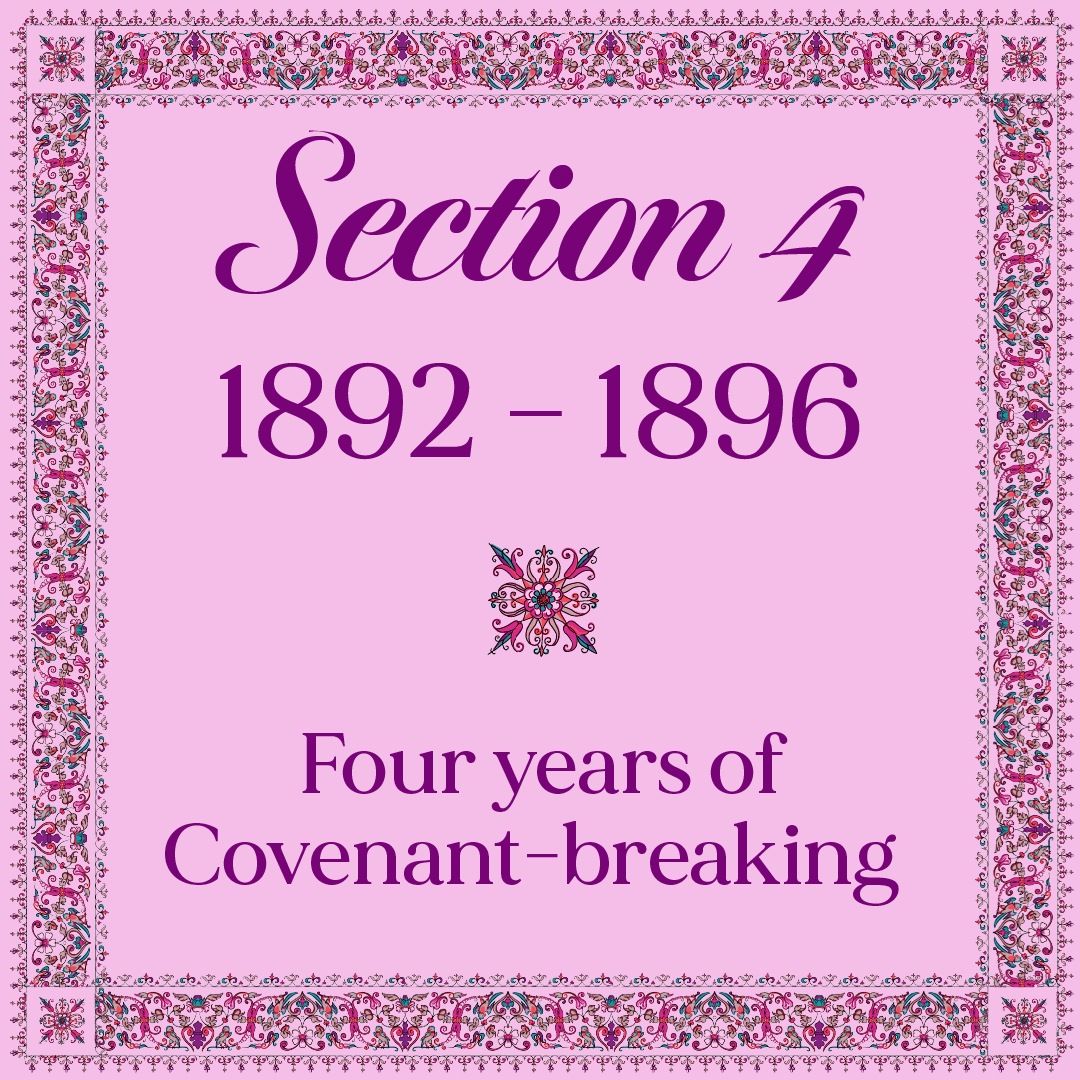

An illustration of those who turned towards and against the Covenant after the Kitáb-i-‘Ahd was made public, unleashing four years of Covenant-breaking and spiritual agony for 'Abdu'l-Bahá and the Greatest Holy Leaf. Source: Bahá'í Media Bank © Bahá'í International Community 2024.
The first severe test of 'Abdu'l-Bahá’s ministry was a period of 4 years of Covenant-breaking spearheaded by Mírzá Muḥammad-'Alí, His own half-brother.
Mírzá Muḥammad-'Alí’s heart was burning with an uncontrollable and soul-devouring jealousy provoked by, in Shoghi Effendi’s words, the “admitted preeminence of ‘Abdu’l-Bahá in rank, power, ability, knowledge and virtue, above all the other members of His Father’s family.”
This jealousy also consumed other members of Bahá'u'lláh’s family. None of them could stand the high marks of honor which 'Abdu'l-Bahá had received from Bahá'u'lláh but also the Bahá'ís.
From 1892 to 1896, 'Abdu'l-Bahá suffered four long years of spiritual agony during which He would have to seek solace in the countryside of the Holy Land away from the toxic atmosphere of 'Akká.
For four years, 'Abdu'l-Bahá constantly pleaded in vain with Mírzá Muḥammad-'Alí and his followers not to break the Covenant.
The stress of this prolonged period of crisis placed a great strain on 'Abdu'l-Bahá and His family. The Greatest Holy Leaf cheered the heart and reinforced the efforts of 'Abdu'l-Bahá, providing Him with a great source of comfort and practical support.
Crises such as these were the Greatest Holy Leaf’s qualities of calm strength, absolute steadfastness, and reliability were not only most obvious but most precious.
There is no doubt that His sister was a great consolation and a valuable ally to a constantly besieged and bereaved 'Abdu'l-Bahá.
Furthermore, the Greatest Holy Leaf’s knowledge of the Faith, her clear understanding of the Covenant, and her unwavering support for its appointed Center were strengths that ‘Abdu’l-Bahá could call upon and utilize in his efforts to protect the Bahá’í Cause.

The first photo of 'Abdu'l-Bahá was taken in 1868, and the next photograph after that was taken in 1911. Between the two photographs, there are 43 years where we have no photographs of 'Abdu'l-Bahá.
During these four trying years during which the Covenant was being fiercely attacked, Bahíyyih Khánum rose the challenge and stood by 'Abdu'l-Bahá’s side.
Although we have little visibility on the exact range and scope of her role in the Faith during this time, it is very clear from her letters that one of the Greatest Holy Leaf’s exceptional skills was that she was a gifted communicator and a talented writer who was able to educate Bahá'ís around the world about the true spiritual nature of the station of 'Abdu'l-Bahá.
Bahíyyih Khánum was able to convey her pristine clarity of vision to all those she either came in contact with in person or corresponded with, constantly emphasizing the importance for individual believers of steadfastness in the Covenant.
Bahíyyih Khánum wrote to a Bahá'í woman in the east:
Praise be to God that He has enabled you, His well-assured leaf, to magnify at all times the glory of His gracious countenance, has sustained your life through the remembrance of His Beauty, has suffered you to rid yourself of all attachment to any one save Him that you may continually commune with His love.
He has graciously assisted you to remain faithful to His weighty and irrefutable Testament, to cling tenaciously to the hem of the robe of the Centre of the Covenant of God, the All-Bountiful, and to fix your gaze entirely upon the luminous face of “Him Whom God hath purposed,” the One “Who hath branched from the pre-existent Root.” In truth, a myriad praises and thanksgiving should be offered in appreciation of this outpouring of divine favours and blessings.
We implore the Kingdom of our Lord, the All-Glorious, that He may continually waft upon you His vitalizing breaths, may enrapture you by the uplifting transports of His delight, may quicken you through His Holy Spirit and may grant you confirmation to serve His maidservants and His leaves.
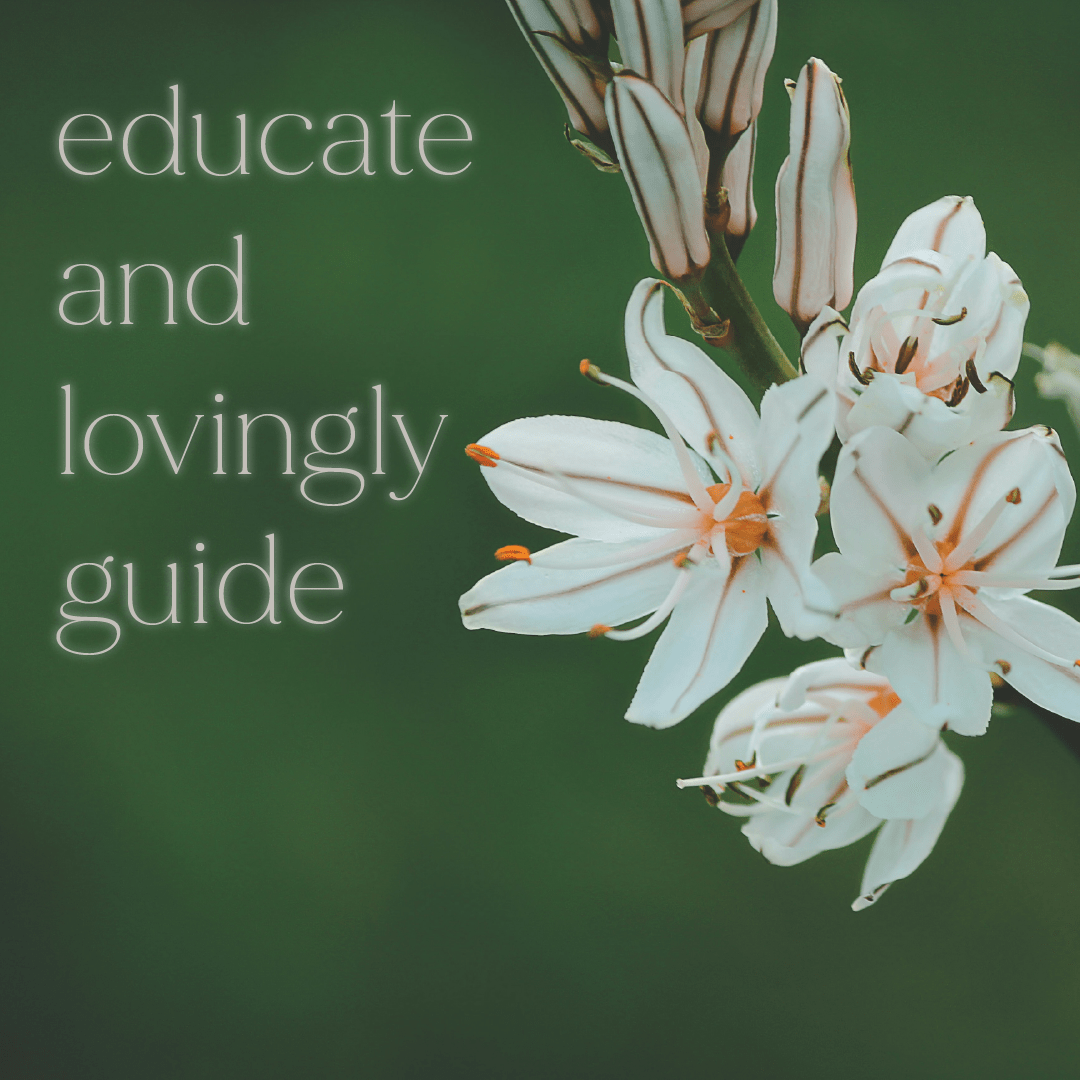
Background photo by Aziz Acharki on Unsplash.
Dr. Janet Khan, author of Prophet’s Daughter, estimates that the Greatest Holy Leaf played a decisive role in the Holy Family as well:
Beyond her participation in educating the believers through her correspondence, it seems probable that the Greatest Holy Leaf would also have worked actively to educate and lovingly guide the members of the extended family who were opposed to ‘Abdu’l-Bahá’s appointment in the years before their formal separation from the Faith.
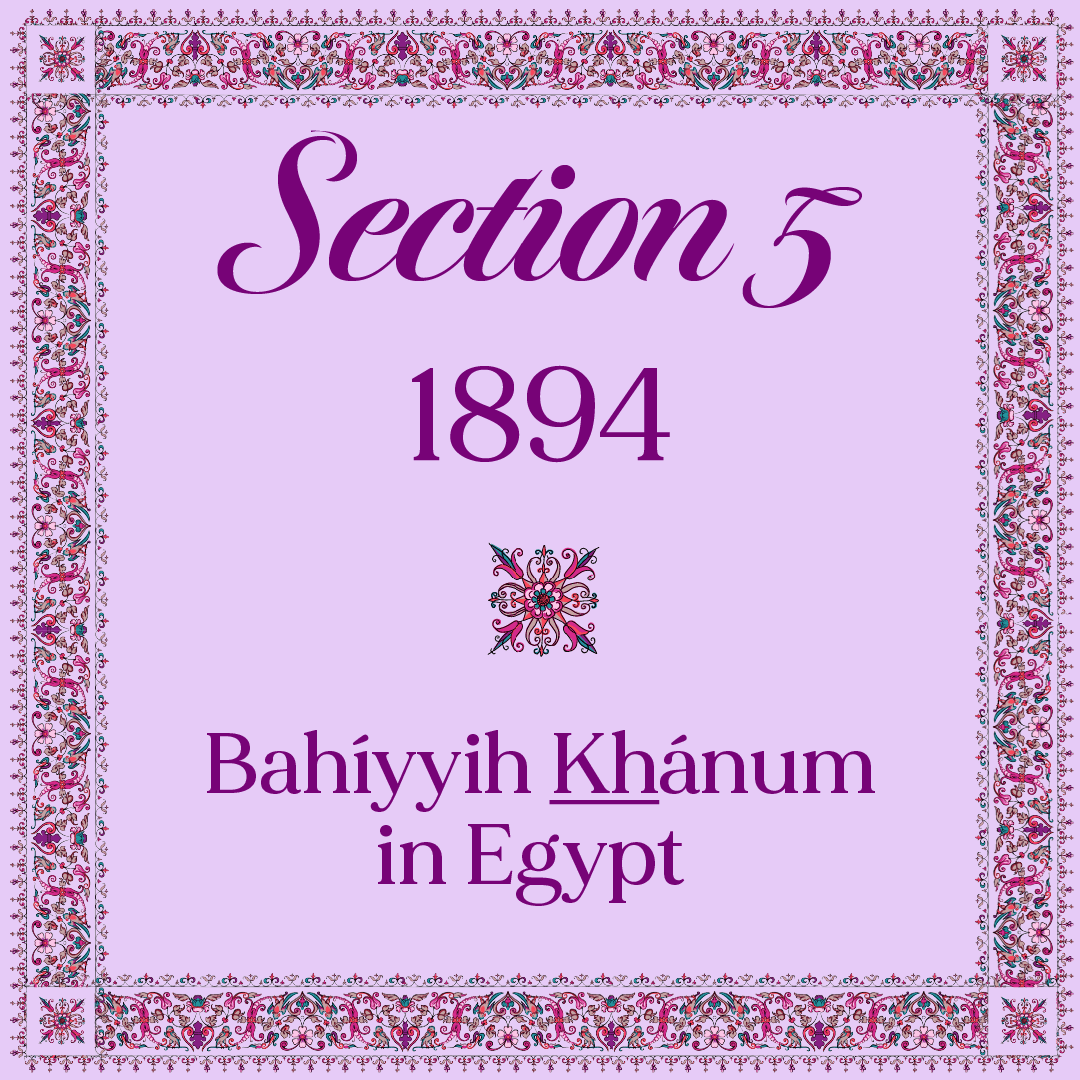
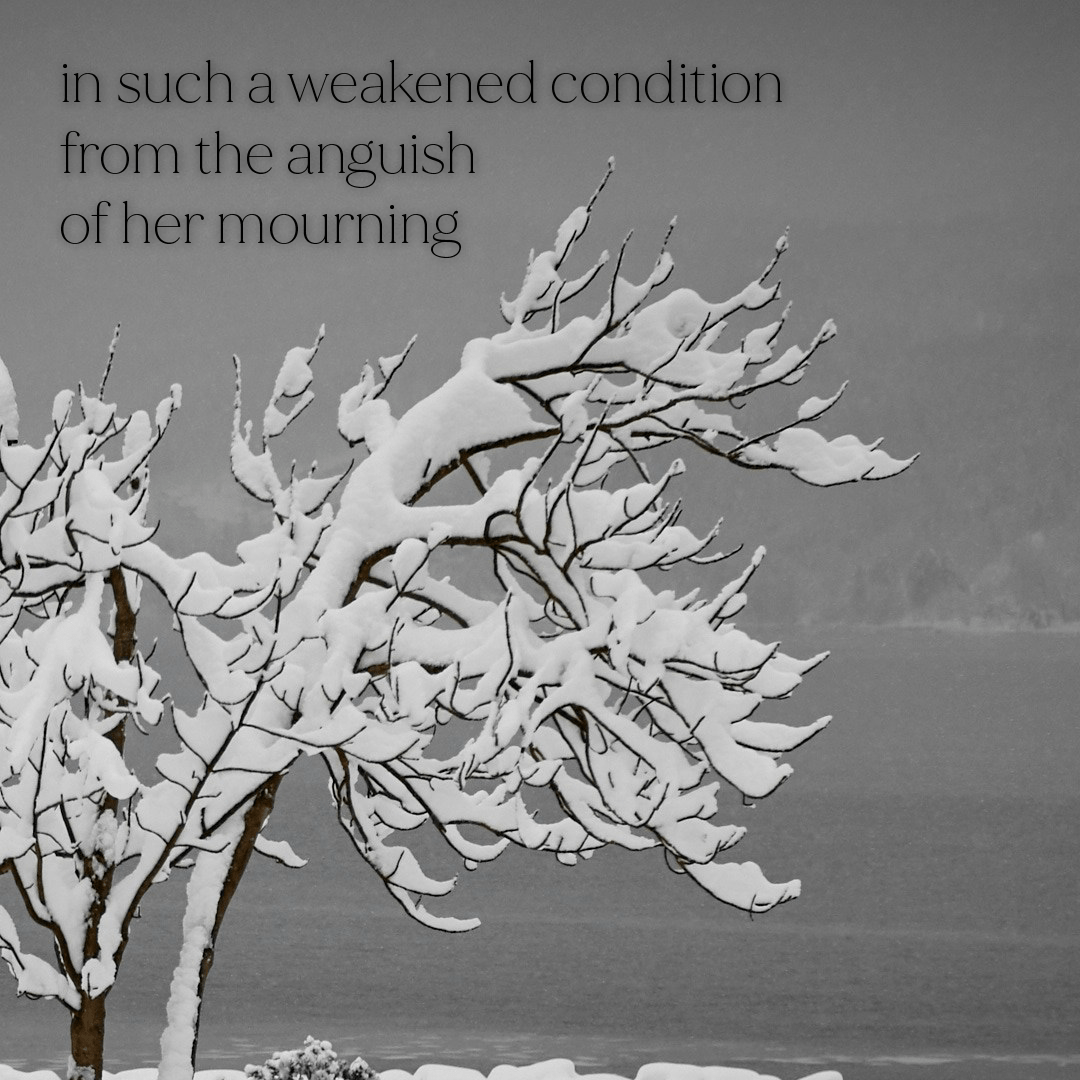
Background photo by Vidar Nordli-Mathisen on Unsplash.
The two years following the Ascension of Bahá'u'lláh, the Covenant-breaking crisis within the Holy Family and the community of believers, took an immense toll on Bahíyyih Khánum’s health and she began wasting away.
The anguish of her mourning was so intense that her body became thin, feeble, and weakened.
When the Greatest Holy Leaf began voicing her desire to leave this world, 'Abdu'l-Bahá became greatly concerned for his cherished sister’s health, and He took the matters in His own hands and revealed a very significant Tablet to his dear friend Ḥájí Mírzá Ḥasan-i-Khúrásání, an eminent and dedicated Persian Bahá'í living in Egypt:
My sister, for a considerable period, that is, from the day of Bahá'u'lláh's ascension, grown so thin and feeble, and was in such a weakened condition from the anguish of her mourning, that she was close to breakdown.
Although, so far as she was concerned, it was her dearest wish to drain her cup and wing her way to the realms where the Divine Essence shineth in glory, still this servant could not bear to behold her in that state. Then it occurred to me that, God be thanked, I have such an unfailing comforter as Jinab-i-Ḥájí [Ḥájí Mírzá Ḥasan-i- Khurásáni] and it would be well to make him my partner in distress. I therefore determined to send her to Egypt, to provide her with a change of air.
Although this will certainly cause thee trouble and inconvenience, still, I trust that out of God's bounty, it will also bring thee much joy and good cheer.
It was the Greatest Holy Leaf’s first trip since she had arrived in the Holy Land, almost 30 years before, and 'Abdu'l-Bahá knew His sister’s self-sacrificing nature so well that He instinctively knew she needed, as He said, “a change of air.”
'Abdu'l-Bahá made all the arrangements for Bahíyyih Khánum’s journey.
He asked his eldest daughter, Ḍíyá‘íyyih Khánum, Shoghi Effendi’s future mother, to accompany Bahíyyih Khánum, and asked her to be a “close, a constant and cheerful companion to my honoured and distinguished sister,” adding:
Unceasingly, with the utmost vigour and devotion, exert thyself, by day and night, to gladden her blessed heart; for all her days she was denied a moment of tranquillity. She was astir and restless every hour of her life. Moth-like she circled in adoration round the undying flame of the Divine Candle, her spirit ablaze and her heart consumed by the fire of His love...
Bahíyyih Khánum left the Holy Land for Egypt sometime in 1894.
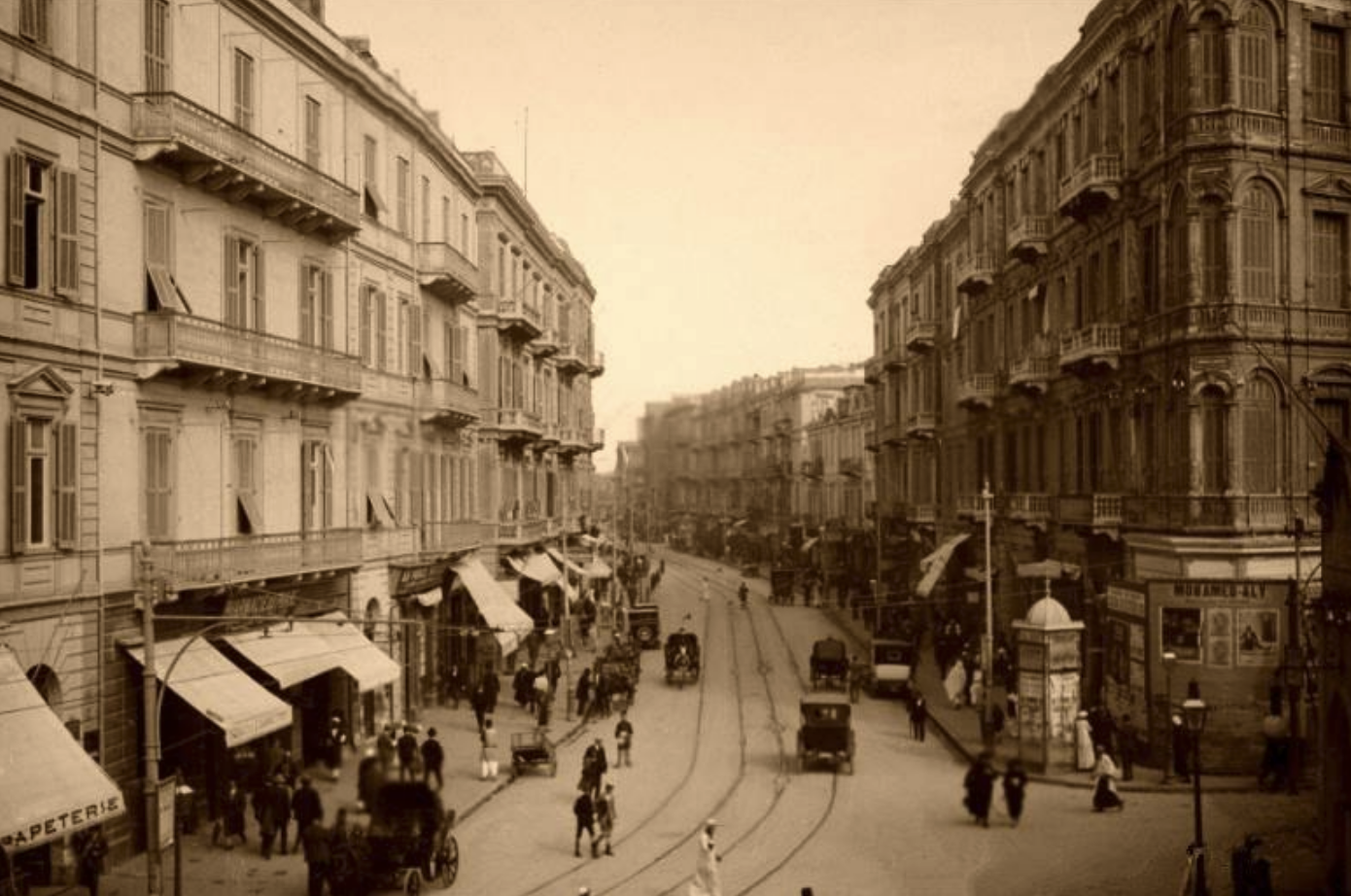
As we have no information regarding the city where the Greatest Holy Leaf spent her time in Egypt, this 1920 photograph of a street scene on Ramleh boulevard in Alexandria is meant as a symbolic illustration. © Roger Viollet, Egypt in 1920 via Monarchy and Dynasty.
'Abdu'l-Bahá arranged a dignified and safe place for Bahíyyih Khánum’s stay in Egypt in the home of Ḥájí Mírzá Ḥasan-i-Khúrásání. 'Abdu'l-Bahá had informed Ḥájí Mírzá Ḥasan-i-Khúrásání of Bahíyyih Khánum’s health, and while she was recuperating there, 'Abdu'l-Bahá wrote her letters which showed the depth of His attachment and concern for her well-being.
In one of His letters to Bahíyyih Khánum, 'Abdu'l-Bahá offers to send additional family members to Egypt to keep her company, even offering to send His own wife and Bahíyyih Khánum’s closest friend, Munírih Khánum, all in an effort, as 'Abdu'l-Bahá phrased it, “so that thou wilt not be homesick.”
'Abdu'l-Bahá ended His letter to Bahíyyih Khánum with these touching words:
That thou shouldst spend a few days of peace and rest, is my dearest wish. We here, God be thanked, are all enjoying the best of health. I have been better lately, and sleeping well at night. Rest assured.
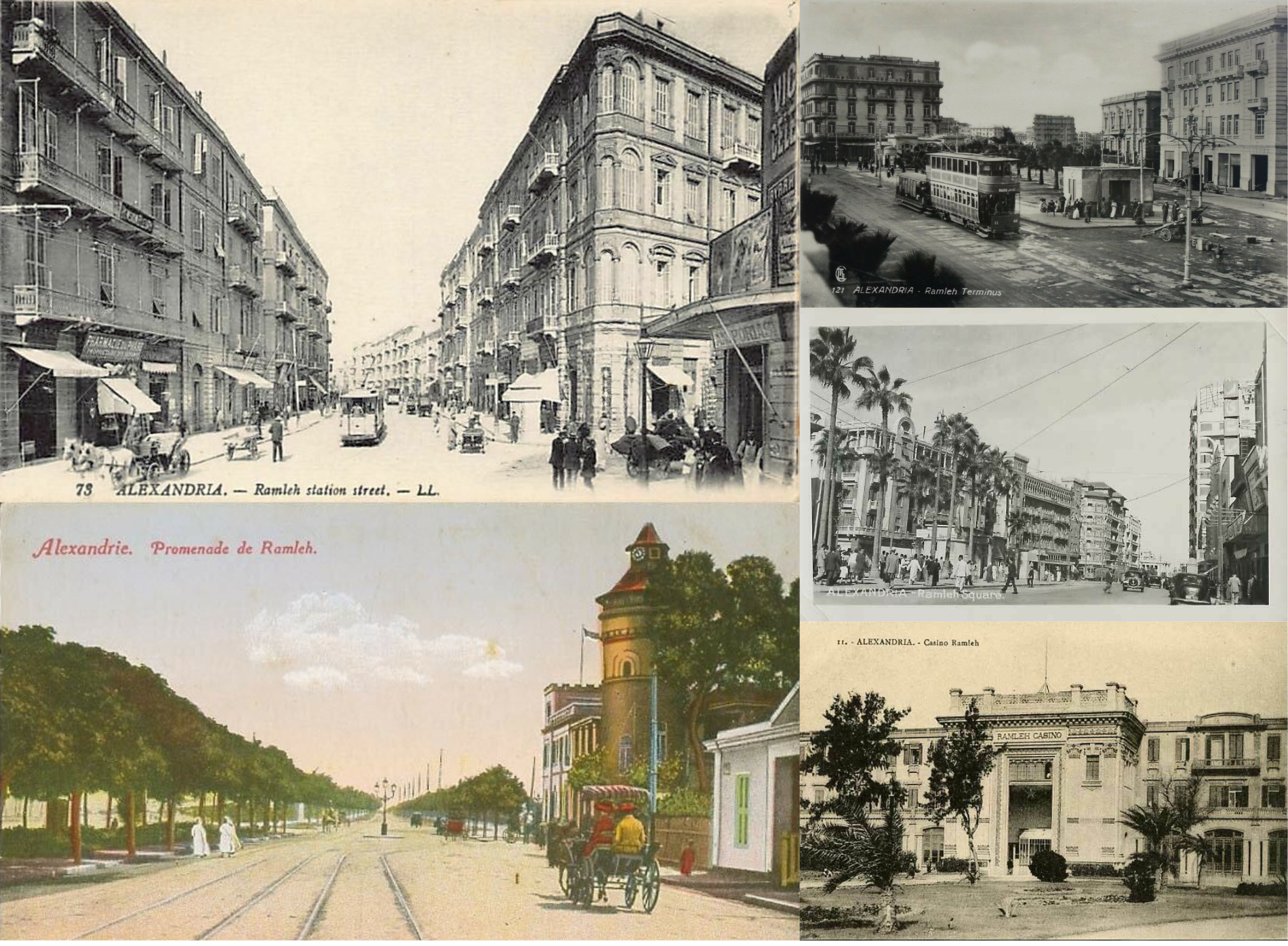
Another symbolic illustration of the Greatest Holy Leaf’s stay in Egypt with a collage of postcard of Ramleh.
Ḥájí Mírzá Ḥasan-i-Khúrásání had hired a Berber servant named Ṣáliḥ Áqá to attend to the Greatest Holy Leaf’s needs.
Ṣáliḥ Áqá was extremely qualified. He had worked in the court of Ismá‘íl Páshá, the Ottoman Viceroy of Egypt, and he had mastered all the courtesy and etiquette that pertained to serving of a royal audience. In addition to that, Ṣáliḥ Áqá was fluent in Arabic and Turkish.
The Greatest Holy Leaf’s visit to Egypt was wonderfully reinvigorating.
She was instilled with a new breath of fresh air, mainly due the fact she was freed and far away from the toxicity of the Covenant-breakers in 'Akká.
The Greatest Holy Leaf also had a tremendous effect on the local Bahá'ís. They were filled with so much joy and enthusiasm at having the daughter of Bahá'u'lláh and the sister of 'Abdu'l-Bahá among them!
The local Bahá'ís sent Bahíyyih Khánum absolutely beautiful letters, in true Persian fashion, expressing their nothingness and humility and begging for her prayers and confirmations. Most of the time, during her stay, the Greatest Holy Leaf responded to their letters in person, verbally, as they attained her presence.
Bahíyyih Khánum had been so pleased with Ṣáliḥ Áqá’s service, his modesty, and his meticulousness that she invited him to return with her to Haifa to serve 'Abdu'l-Bahá in His home.
After five months in Egypt, Bahíyyih Khánum returned to the Holy Land with Ṣáliḥ Áqá.
Ṣáliḥ Áqá would remain in the Holy Land for some years, in 'Abdu'l-Bahá’s service.
'Abdu'l-Bahá’s concern for His beloved sister was a constant in His life. At another point in Bahíyyih Khánum’s life, she became ill and bed-ridden. Smilingly, 'Abdu'l-Bahá came to her bedside and said to her:
Do what you wish, but I have work for you.
It was 'Abdu'l-Bahá’s way of telling His cherished sister she was precious to Him and that He needed her.

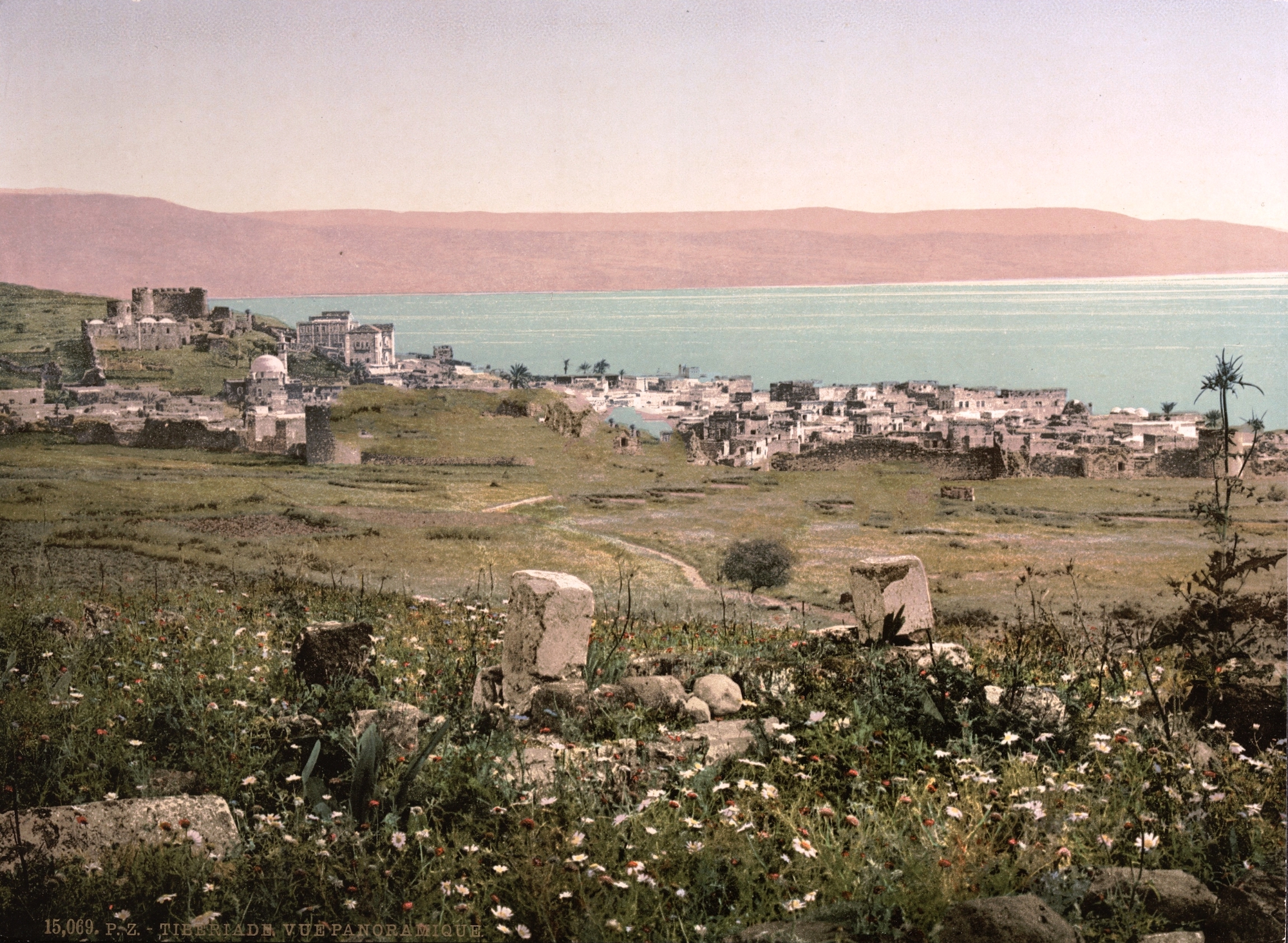
Panoramic view, Tiberias, Holy Land, between 1890 and 1900 Source: Wikimedia Commons.
In late 1895, after the Greatest Holy Leaf returned from Egypt, it was 'Abdu'l-Bahá’s turn to seek solace from the first three immensely trying years of His ministry in the countryside.
'Abdu'l-Bahá had been worn down by the constant mischief stirred up by His Covenant-breaking family, and He left 'Akká and the house of 'Abbúd and withdrew in the peace and tranquility of Tiberias, a sleepy city on the Sea of Galilee, 50 kilometers (30 miles) east. To this day, we do not know the exact duration of 'Abdu'l-Bahá’s stay in Tiberias in late 1895 – 1896.
Bahíyyih Khánum, now 49 years old, was the most senior member of the Holy Family after 'Abdu'l-Bahá, and had been elevated by Bahá'u'lláh during His lifetime to a rank above and beyond all women of the Bahá'í Dispensation.
She was 'Abdu'l-Bahá’s trusted, faithful, loving sister, and with 'Abdu'l-Bahá’s’ first absence from the Center of the Cause in 'Akká, an entirely new avenue of service opened in her life.
For the first time in her life, the Greatest Holy Leaf took on responsibilities of safeguarding the Faith and its Covenant at its center during the absence of the Head of the Faith, a role she would take on again and again over the next 37 years until her passing.
'Abdu'l-Bahá was not in 'Akká but neither was He very far away, and Bahíyyih Khánum kept Him apprised of all the developments, always writing for His approval for every important matter.
Soon after His arrival in Tiberias, sometime in 1895, 'Abdu'l-Bahá wrote to Bahíyyih Khánum:
O my spiritual sister!
God be praised, through the Ancient Beauty's grace and bounty, we have set foot safe and sound upon this shore, and arrived in this town [Tiberias].
These coasts were once the place where the breezes of God's loving kindness blew, and here in this sacred Vale the Son of Spirit [Jesus] raised up His call of “Here am I, O Thou My Lord! Here am I!” That is why we here perceive, from every direction, the sweet breathings of holiness.
My meaning is, rest thou assured, this servant is suffering neither from any trouble, nor hardship, nor fatigue. I am looking after myself, and keeping away from all mental preoccupations; all, that is, except for one thought, which doth indeed disquiet the mind—and that is, God forbid, that thou shouldst sorrow.
I hope that out of the bestowals and bounties of the Ancient Beauty, He will in His grace bring comfort to every heart.
'Abdu'l-Bahá would return, time and again to Tiberias and the Sea of Galilee during His ministry, seeking not only the solace of the place but its direct association with Jesus Christ, Whom 'Abdu'l-Bahá loved with all His heart.
It was during 'Abdu'l-Bahá’s absence from 'Akká that an event took place that would change the course of Bahá'í history forever, and it came in the shape of a very significant and prophetic wedding, which we will cover in the next Part.
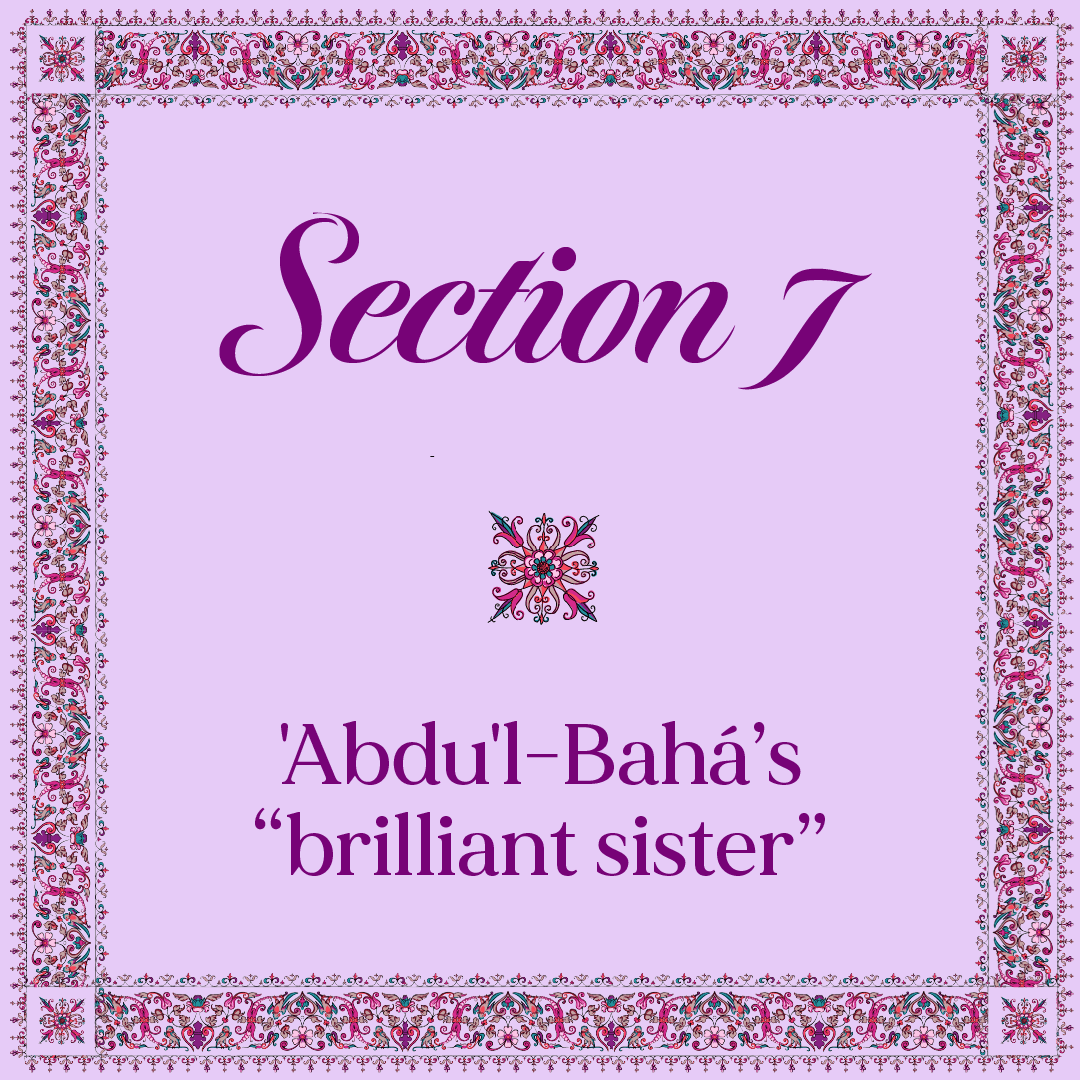
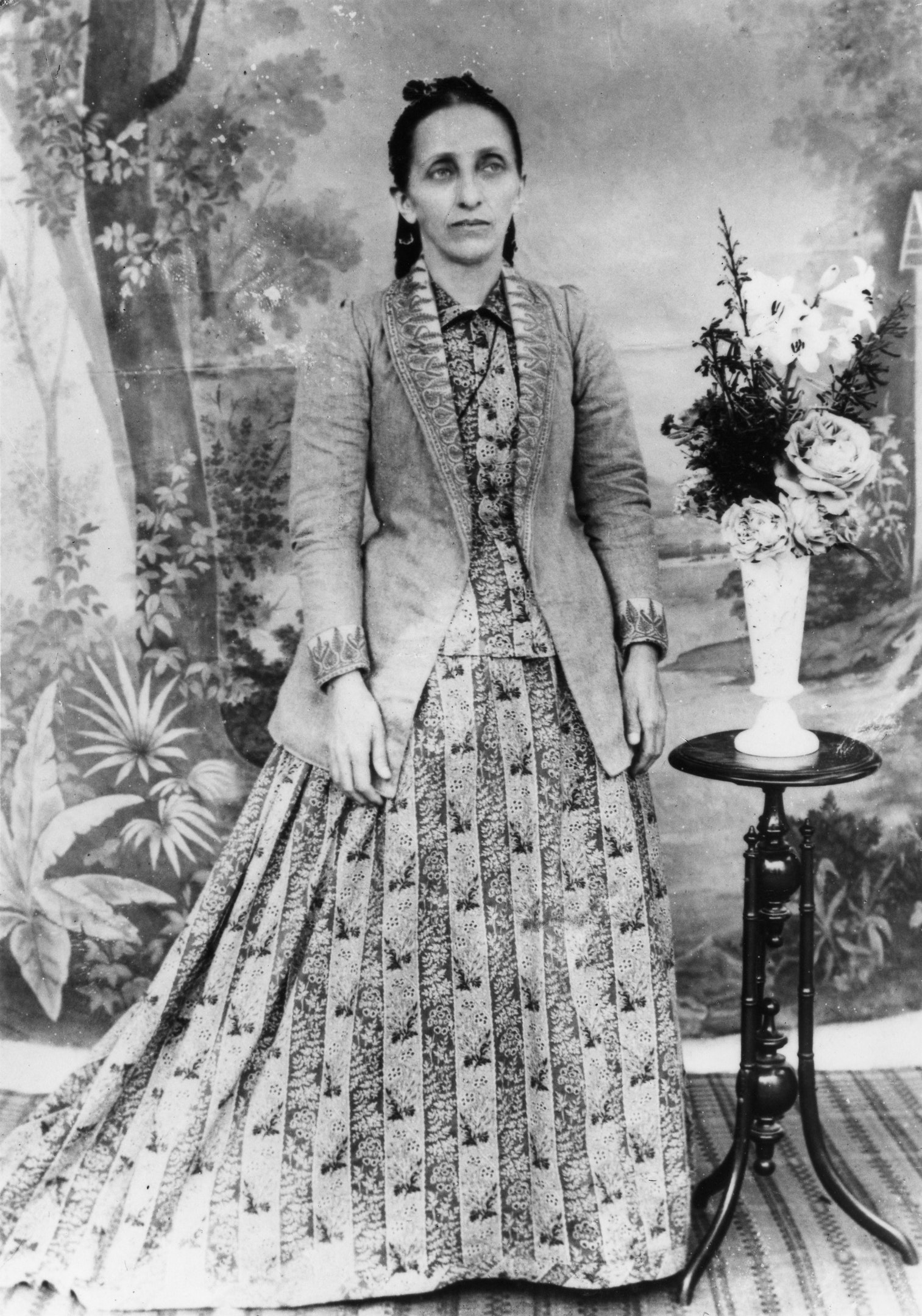
Portrait of Bahíyyih Khánum around 1895, exactly around the time 'Abdu'l-Bahá is in Tiberias and writes her a letter. Source: Bahá'í Media Bank, © Bahá'í International Community 2024.
From the beginning of 'Abdu'l-Bahá’s ministry, the Greatest Holy Leaf was the only member left of Bahá'u'lláh’s immediate family who had remained firm in the Covenant and stayed by 'Abdu'l-Bahá’s side to cheer his heart, and comfort and assist Him.
Almost all the other relatives of Bahá'u'lláh were pitted against 'Abdu'l-Bahá and Bahíyyih Khánum.
In 'Abdu'l-Bahá’s family, Bahíyyih Khánum was aided in her service to the Master by His wife Munírih Khánum, and those of His daughters who were old enough to help.
Bahíyyih Khánum would be called upon to defend the Covenant in the coming years during 'Abdu'l-Bahá’s long absence from the Holy Land to visit Europe and America.
The Greatest Holy Leaf had already forged her spiritual strength in service to Bahá'u'lláh during His ministry, but the wide range and variety of her services to 'Abdu'l-Bahá as Center of the Covenant trained her further to prepare her for the storm of Covenant-breaking that she would have to face.

Closeup of the 1895 portrait of Bahíyyih Khánum. Source: Bahá'í Media Bank, © Bahá'í International Community 2024.
In a Persian letter dated 15 July 1932—the day of her passing—addressed to the Bahá'ís of the east, Shoghi Effendi described Bahíyyih Khánum as 'Abdu'l-Bahá’s “brilliant sister.”
'Abdu'l-Bahá and Bahíyyih Khánum were only two years apart, so they were 48 and 46 when 'Abdu'l-Bahá became the Center of the Covenant.
They had known each other their entire life, and they had spent those lives living together, almost never apart for a moment it would seem. Bahíyyih Khánum adored 'Abdu'l-Bahá and He, in turn, addressed her in His Tablets as “my well-beloved and deeply spiritual sister” or “my honoured and distinguished sister.”
Beyond the relationship of brother and sister, however, there was a mystic, spiritual bond between 'Abdu'l-Bahá and Bahíyyih Khánum.
'Abdu'l-Bahá was not only profoundly aware of the Greatest Holy Leaf’s lofty spiritual rank and her unsurpassed purity of character. He also knew of her unquestioned allegiance to the Covenant and her willingness to sacrifice herself in service for the Bahá'í Faith.
Bahíyyih Khánum would be 'Abdu'l-Bahá’s most loyal and able supporter, an unwavering source of wisdom and good judgement,
During 'Abdu'l-Bahá’s ministry, Bahíyyih Khánum would protect the Faith, would act as 'Abdu'l-Bahá’s competent deputy, and continue to masterfully manage the household of the Holy Family.
SOURCES FOR PART V
8 – 29 May 1892: Bahá’u’lláh’s illness
Shoghi Effendi, God Passes By.
Leaves of the Twin Divine Trees, Baharieh Rouhani Ma’ani, George Ronald, Oxford, 2013, page 156.
Adib Taherzadeh, The Revelation of Bahá’u’lláh Volume 4: Mazra’ih and Bahjí 1877-1892, page 414.
Adib Taherzadeh, The Revelation of Bahá’u’lláh Volume 4, page 414 and 419.
The Chosen Highway, Lady Blomfield, Bahá’í Publishing Trust, Wilmette, Ill. 1975, pages 105-107.
Sunday 29 May 1892 at 3 o’clock in the morning: The Ascension of Bahá’u’lláh
Shoghi Effendi. God Passes By.
Adib Taherzadeh, The Revelation of Bahá’u’lláh Volume 4: Mazra’ih and Bahjí 1877-1892, page 417.
Lady Blomfield The Chosen Highway.
‘Abdu’l-Bahá: Center of the Covenant
Prophet’s Daughter: The Life and Legacy of Bahíyyih Khánum, Outstanding Heroine of the Bahá’í Faith, Janet A. Khan, Bahá’í Publishing Trust, Wilmette, 2005, pages 52-53.
After 29 May 1892: Bahíyyih Khánum’s heartbreak
Leaves of the Twin Divine Trees, Baharieh Rouhani Ma’ani, George Ronald, Oxford, 2013, pages 158-159.
The Greatest Holy Leaf’s steadfastness in times of crisis
Leaves of the Twin Divine Trees, Baharieh Rouhani Ma’ani, George Ronald, Oxford, 2013, pages 158-159.
May 1892: Bahíyyih Khánum’s letter about the Ascension of Bahá’u’lláh
Prophet’s Daughter: The Life and Legacy of Bahíyyih Khánum, Outstanding Heroine of the Bahá’í Faith, Janet A. Khan, Bahá’í Publishing Trust, Wilmette, 2005, pages 45-46.
The Revelation of Bahá’u’lláh, Volume 4, Adib Taherzadeh, George Ronald, Oxford, 1987, pages 59-60.
Wikipedia: Varqá.
Wikipedia: Mírzá Badí’u’lláh.
Wikipedia: Mírzá Ḍíyá’u’lláh.
1892-1896: The toxic storm of Covenant-breaking
Prophet’s Daughter: The Life and Legacy of Bahíyyih Khánum, Outstanding Heroine of the Bahá’í Faith, Janet A. Khan, Bahá’í Publishing Trust, Wilmette, 2005, page 53-56.
The Greatest Holy Leaf supports ‘Abdu’l-Bahá during the Covenant-breaking crisis
Prophet’s Daughter: The Life and Legacy of Bahíyyih Khánum, Outstanding Heroine of the Bahá’í Faith, Janet A. Khan, Bahá’í Publishing Trust, Wilmette, 2005, pages 57-59.
The Greatest Holy Leaf’s role within the Holy Family
Prophet’s Daughter: The Life and Legacy of Bahíyyih Khánum, Outstanding Heroine of the Bahá’í Faith, Janet A. Khan, Bahá’í Publishing Trust, Wilmette, 2005, pages 57-59.
1894: ‘Abdu’l-Bahá becomes concerned for Bahíyyih Khánum’s declining health
Prophet’s Daughter: The Life and Legacy of Bahíyyih Khánum, Outstanding Heroine of the Bahá’í Faith, Janet A. Khan, Bahá’í Publishing Trust, Wilmette, 2005, pages 46-47.
Leaves of the Twin Divine Trees, Baharieh Rouhani Ma’ani, George Ronald, Oxford, 2013, pages 160-161.
A Lifetime with ‘Abdu’l-Bahá Reminiscences of Khalíl Shahídí, Translated and Annotated by Ahang Rabbani, Witnesses to Bábí and Bahá’í History Volume 9, page 108.
1894: ‘Abdu’l-Bahá arranges The Greatest Holy Leaf’s stay in Egypt
Prophet’s Daughter: The Life and Legacy of Bahíyyih Khánum, Outstanding Heroine of the Bahá’í Faith, Janet A. Khan, Bahá’í Publishing Trust, Wilmette, 2005, pages 46-47.
Leaves of the Twin Divine Trees, Baharieh Rouhani Ma’ani, George Ronald, Oxford, 2013, pages 160-161.
A Lifetime with ‘Abdu’l-Bahá Reminiscences of Khalíl Shahídí, Translated and Annotated by Ahang Rabbani, Witnesses to Bábí and Bahá’í History Volume 9, page 108.
The Greatest Holy Leaf’s five months in Egypt
Prophet’s Daughter: The Life and Legacy of Bahíyyih Khánum, Outstanding Heroine of the Bahá’í Faith, Janet A. Khan, Bahá’í Publishing Trust, Wilmette, 2005, pages 46-47.
Leaves of the Twin Divine Trees, Baharieh Rouhani Ma’ani, George Ronald, Oxford, 2013, pages 160-161.
Memories of the Báb, Bahá’u’lláh and ‘Abdu’l-Bahá: Memoirs of Mírzá Habíbu’lláh Afnán edited and translated by Ahang Rabbani, PDF page 30.
Black Pearls: Servants in the Household of the Bab and Baha’u’llah, by Abul-Qasim Afnan, Kalimat Press, 1999, pages 45-46
A Lifetime with ‘Abdu’l-Bahá Reminiscences of Khalíl Shahídí, Translated and Annotated by Ahang Rabbani, Witnesses to Bábí and Bahá’í History Volume 9, page 108.
‘Abdu’l-Bahá’s letter to the Greatest Holy Leaf from Tiberias
Leaves of the Twin Divine Trees, Baharieh Rouhani Ma’ani, George Ronald, Oxford, 2013, page 162-163.
Bahíyyih Khánum: The Greatest Holy Leaf by Bahá’u’lláh, Abdu’l-Bahá, Shoghi Effendi, and Bahíyyih Khánum, compiled by Research Department of the Universal House of Justice Haifa: Bahá’í World Centre Publications (1982): Selection 15 from the Writings of ‘Abdu’l-Bahá, pages 15-16.
The Greatest Holy Leaf: ‘Abdu’l-Bahá’s comfort and ally
Prophet’s Daughter: The Life and Legacy of Bahíyyih Khánum, Outstanding Heroine of the Bahá’í Faith, Janet A. Khan, Bahá’í Publishing Trust, Wilmette, 2005, pages 48 and 51-52.
‘Abdu’l-Bahá’s “brilliant sister”
Prophet’s Daughter: The Life and Legacy of Bahíyyih Khánum, Outstanding Heroine of the Bahá’í Faith, Janet A. Khan, Bahá’í Publishing Trust, Wilmette, 2005, pages 48 and 51-52.
“Brilliant sister” is from Bahíyyih Khánum, the Greatest Holy Leaf: Bahíyyih Khánum: The Greatest Holy Leaf from the writings and letters of Bahá’u’lláh, Abdu’l-Bahá, Shoghi Effendi, and Bahíyyih Khánum, compiled by Research Department of the Universal House of Justice Haifa: Bahá’í World Centre Publications, 1982: From the letters of Shoghi Effendi: Number 5, page 28: Letter dated 15 July 1932 addressed to the Bahá’ís of the East. (Translated from the Persian).
![]()
 8 – 29 May 1892: Bahá’u’lláh’s illness
8 – 29 May 1892: Bahá’u’lláh’s illness

